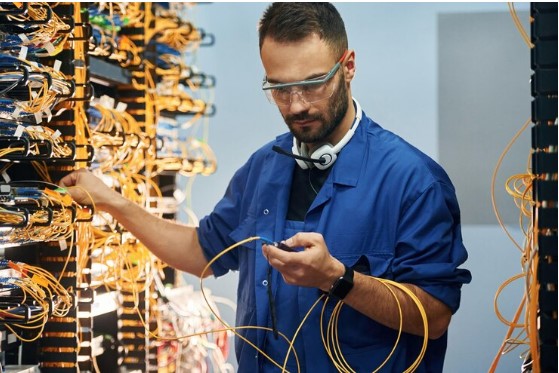In the rapidly expanding digital world, the demand for high-speed internet and data services continues to skyrocket, making the role of fiber optic cables more crucial than ever. One of the key methods of installing these vital lifelines is by burying them underground. This not only protects the cables from physical damage but also ensures consistent, high-quality data transmission. However, burying fiber optic cables is a task that requires precision, expertise, and adherence to best practices. This article outlines the essential steps and best practices for burying fiber optic cable, and why RIAM Enterprises is the certified partner you need for a job of this magnitude and importance.
Steps for Burying Fiber Optic Cable
1. Planning and Permitting: Before any excavation begins, thorough planning is essential. This includes obtaining necessary permits from local authorities, identifying the best route for the cables that avoid existing utilities, and ensuring the plan complies with all local regulations and standards.
2. Choosing the Right Type of Cable: Not all fiber optic cables are suitable for direct burial. It’s crucial to select the appropriate type of cable designed for underground installation, which typically features robust, armored protection to withstand the harsh conditions underground.
3. Trenching: Once planning is complete, the next step is trenching. The depth of the trench depends on local regulations, typically ranging from 24 to 42 inches. It’s essential to ensure the trench is of the correct depth and the soil conditions are suitable for the planned installation.
4. Laying Conduit: Although not always necessary, laying conduit can provide additional protection for the fiber optic cables. This is particularly recommended in areas where the cable might need to be upgraded or replaced in the future, as it facilitates easier access.
5. Installing the Cable: When laying the fiber optic cable, care must be taken to avoid sharp bends and excessive tension, as these can damage the cable. Using proper cable laying equipment and techniques is critical to prevent damage during installation.
6. Backfilling: After the cable is laid, the trench is backfilled with a soft bedding compound to protect the cable, followed by the original excavated material. It’s important to avoid sharp rocks or debris that could damage the cable.
7. Testing and Documentation: Once the cable is buried, comprehensive testing is necessary to ensure the integrity and performance of the fiber optic link. Documentation of the cable route, depth, and testing results is also essential for future maintenance and troubleshooting.
Best Practices for Burying Fiber Optic Cable
Use of Warning Tape: Placing a warning tape above the buried cable can help prevent accidental damage during future excavations.
Regular Inspections: Conduct regular inspections during the installation process to ensure that all standards and specifications are being met.
Professional Training: Ensure that the team involved in the installation is professionally trained and aware of the best practices and safety measures.
Partnering with RIAM Enterprises
For a task as critical as burying fiber optic cable, partnering with a certified and experienced contractor like RIAM Enterprises ensures that the job is done right. RIAM Enterprises, with its certification and extensive experience in fiber optic installations, stands out as an ideal partner. They not only follow all the best practices outlined above but also bring a level of precision and expertise that guarantees the longevity and reliability of the installation.
RIAM Enterprises understands the importance of a meticulously planned and executed fiber optic cable installation. Their commitment to quality, combined with a deep understanding of local regulations and environmental conditions, makes them a trusted partner for your underground fiber optic cable installation needs.
Conclusion
Burying fiber optic cable is a complex process that requires careful planning, execution, and adherence to best practices. By partnering with RIAM Enterprises, you ensure that your fiber optic cabling needs are handled by certified professionals committed to delivering high-quality, reliable installations. With RIAM Enterprises, you can rest assured that your fiber optic infrastructure is built to last, providing the foundation for your high-speed data transmission needs
 seolounge
seolounge